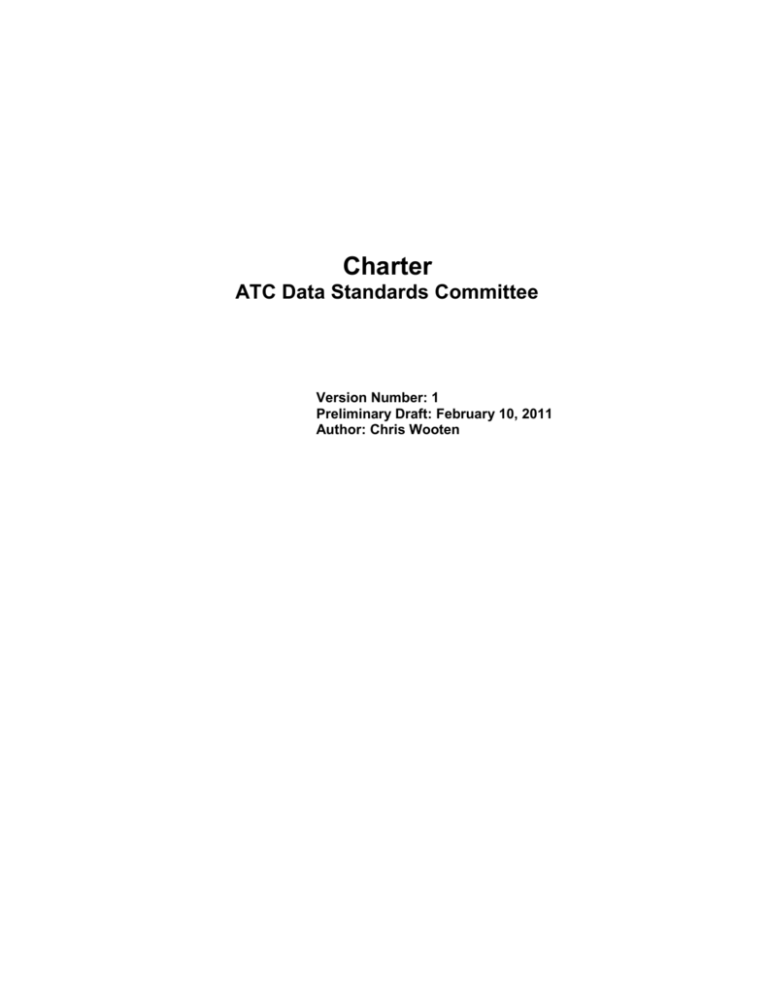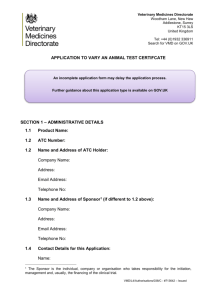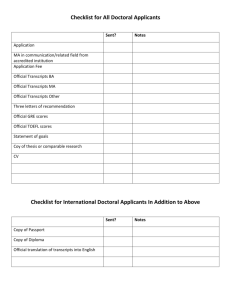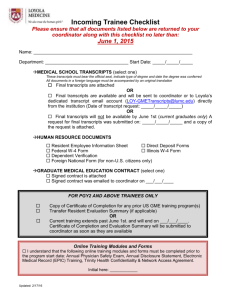ATC Standards Committee Charterv1
advertisement

Charter ATC Data Standards Committee Version Number: 1 Preliminary Draft: February 10, 2011 Author: Chris Wooten Name ATC Data Standards Committee Organization Business Sponsor Dr. Paula Compton, Associate Vice Chancellor, Ann O’Beay, CTO, Ohio Board Of Regents Overview The Articulation and Transfer Clearing house (ATC) is a computer application that facilitates the electronic exchange of student transcripts among Ohio state-assisted higher education institutions. The ATC provides institutions receiving transfer students with additional electronic information regarding how a transfer student’s current coursework matches with his or her new institution’s coursework that is guaranteed to transfer under the Ohio Articulation and Transfer Policies. This helps receiving institutions consider transfer credits in a consistent manner across the state. Ohio’s institutions of higher education benefit from the ATC because electronic transcript exchange allows for significant automation of transfer student processing. Ohio’s higher education students benefit from improved reliability of the processed transcript data at the new institution. Electronic processing of transcripts also speeds the overall transcript evaluation process. Ohio institutions are working toward implementing the technical components to leverage the full capability of the ATC. The transcripts that the ATC delivers electronically are formatted to a nationally-accepted standard developed by the Post-Secondary Electronic Standards Council (PESC) using the XML data interchange language. The ATC XML Transcript Implementation Guide was developed by OBR working with institutions, to come up with a list of data elements to be used for data transfer. In order for the ATC to work as designed, a major component is to identify and gain consensus on the content of those data elements so they can be directly imported into their Student Information System. Preliminary Understanding of Business Case or Need The electronic exchange of student transcripts is a high priority as indicated in the Overview. The fully-functioning exchange of transcripts is also a foundational component of the Chancellor’s concept of a Student Portal. There is a need to standardize data elements that would enable institutions to successfully import the transcripts into their Student Information System. Doing so, the Articulation and Transfer Clearing House can be utilized to its fullest capacity, sending and receiving student transcripts electronically with a high degree of certainty. Objectives At a basic level, data standards refer to the standardization of data elements: (1) defining what to collect, (2) deciding how to represent what is collected. Content of the data elements and policy recommendations need to be standardized. Without data standards and data quality, interoperability in the transmission of transcripts may be compromised. The Committee is charged with the following: Establish a scope and determining the list of data elements to be defined and discussed. Identify technical specifications for each element to facilitate the collection and transport of those elements across education institutions. Solicit feedback and buy-in by sharing standards with broader partnership. Recommendations added to the ATC XML Transcript Implementation Details documents, which will include: o A list of elements with thoroughly documented definitions and business rules o Detailed technical specifications for each element o Documentation of the governance process for maintenance and expansion of the common data standards, detailing: » Who is engaged? » What are the roles and responsibilities of each type of stakeholder? » How are common data standards reviewed, expanded, and considered for sunset? Preliminary Statement of Work The formation of a USO Data Standards Committee charged with defining and gaining consensus on the data element standardization to result in the transmission of transcripts. Solicit feedback and buy-in by sharing standards with broader partnership. The PESC standard is evolving and as it grows, the new elements introduced must be evaluated and adopted as needed as part of the Ohio ATC standards. Policy decisions have a direct influence on data standards and available options. The committee should have an awareness and understanding of those policies as they consider existing and future data elements. In Scope Items in Scope are as follows: Engagement of the community to insure their readiness to send and receive transcripts among USO institution Out of Scope This document does not address activities necessary to support USO technical connections to the ATC. Committee Structure The structure of the ATC Data Standards Committee is as follows: A committee chair will be identified. The committee will schedule regular meetings during the course of each calendar year. The committee will establish a regular communication structure and provide status reports to executive management. Committee Members University Registrars University Admissions Officers University CIOs University IT Management ATC Business Analyst/Technical Liaison eTech Ohio Technical







